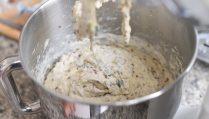I had a different conception of self-rising flour in the past. I always thought it had some sort of proofing agents that are not accessible for the home baker to make at home.
I was very wrong, self rising flour is just your usual all-purpose flour mixed with baking powder and salt, nothing more to it.
Advantages in using self-rising flour
Well, the history of this flour indicates that it was first used in army bases and big quantity factories because using it made the bread be light and airy. Using this flour actually saved time because the baker didn’t need to measure the quantities of all the ingredients, just add the self rising flour and you’re good to go.
That’s actually the main use for self-rising flour today, saving time, it’s good for making all of the fast or flat bread out there, like corn bread, pancakes, it’s also great with cakes and cupcakes.
Downsides of self-rising flour
Weather you make your own self-rising flour or buy it in your supermarket (most supermarkets keep at least 1 brand of self-rising flour) you need to take under consideration the time factor because this product has a low shelf life.
Baking powder lose its strength over time, the reaction you’ll going to get if using an old self rising flour will not be good because less carbon dioxide (the air bubbles) will be released creating a dense dough.
self-rising flour is not to be used in any dough that use yeast or levain, it’s strictly for the flat dough/ fast dough kind of baking, that needs the chemical reaction with the baking powder and some sort of acidic base
How to make self-rising flour
5 cups all-purpose flour
3 tablespoons baking powder
1 teaspoon fine salt
Mix all ingredients and store in a cool place, this flour will be just as good as any store-bought flour.














